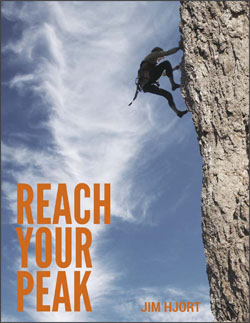How Mindfulness Can Help You Get the Most Out of Life
/I turned 40 this year: a milestone birthday. The even-decade ones carry a special significance, partly because there's no getting around seeing that first digit associated with your name for the first time. It's like the way retail or gasoline prices are presented: the day before my birthday, I was paying $3.99 per gallon, and the next day, an even $4.00. The oil companies and Madison Avenue know what they’re doing: perception is everything.
For me, the full realization of my new numerical prefix came on the morning of my birthday, at the gym. Some cardio equipment likes to know how old you are and, as routine as the procedure is to me, I found myself caught off guard.
Oh. Right.
I paused before punching the number in, just to make sure I would notice what it felt like, for better or worse. To cross the threshold right there in front of everyone, in big green LED numbers.
To me, that pause is a more significant sign of my progression through life than any of the usual ones. Sure, my metabolism won’t let me eat ice cream every day without adverse consequences, but I am also more inclined to make the effort to appreciate the so-called “little moments” than I was in, say, my early 20s.
However, what that effort has taught me is that there really aren’t little or big moments at all, any more than there are little or big inches: an inch is an inch, and a moment is a moment. There is one big difference between inches and moments, though: a moment isn’t an objective measure. It's a product of location, circumstances, and time.
In order to locate an object, you need to know more than its physical coordinates. You need to know the time it is, or will be, at that location. If I ask you to pick me up at the airport, I need to specify an airport, airline, and time. Without any of these, we will not meet.
Then, when you and I do meet at that particular place and instant, there is a moment that has never existed before and never will again, even the tiniest fraction of a second later. So, in this respect a moment is as standardized as an inch: it is an instant; a frozen frame of experience, just like any other.
The time of your life is relative.
However, in practice inches and moments don’t seem equally clear-cut. An inch is likely to look pretty much the same to you no matter what. On the other hand, your experience of some events may flit past in a blur, while others may seem to ooze, perhaps trapping you uncomfortably in an experience you don’t like.
Some people have experienced this phenomenon during a traumatic event, when time seems to slow down dramatically. If this hasn't happened to you, you've surely seen Hollywood’s representation, when the occupants of a car experience a traffic accident in excruciatingly slow motion. Science has an explanation for this.
During times of stress, the amygdala instantly goes into turbo mode, boosting its rate of memory creation. As a result, the passage of time seems to slow down, and we capture a slow-motion, detailed experience of the event. This is the same concept behind the use of high-speed cameras to capture extreme slow-motion footage. (Please refer to almost any program during Discovery Channel’s Shark Week for more information.)
So, our subjective experience of moments is conditioned, in part, by the mind's response to the type of experience we are having. When we are faced with an intense experience like a car crash, our minds meet it with equally intense focus and awareness: we are paying attention.
When no crisis exists, the mind’s natural state is one of repose, like a guard falling asleep at a remote checkpoint. With nothing in particular to occupy its attention, it is content to read magazines. It moves here and there, entertaining us with memories, fantasies, worries, and plans, until something does need attention.
This state of mind is more like time-lapse photography. By taking a series of occasional pictures, the gradual blooming of a flower over the course of a day can be converted into stop-motion animation not unlike a Gumby episode.
This is the way people typically live: fast-forwarding through the DVD of life, stopping for the interesting scenes. Long stretches of absence from the experience of our lives, punctuated by brief moments of awareness. The result is a clipped sequence that gives the illusion of continuity, while failing to convey its real-time richness.
Unfortunately (in this context), in our day-to-day lives we can perform most tasks on autopilot, and aren’t often required to be fully aware of what is going on. For instance, we check in with our experience long enough to know that we're hungry and need to buy groceries.
Then we drive to the store, park, shop, and drive home.
We might have paid close attention as we were selecting a good apple, but we probably spent much more time mentally elsewhere, perhaps planning or remembering things. Before long, the task has been accomplished in a blur. We can find ourselves at our destination with no particular memory of the journey. We may find ourselves at a birthday wondering where in the world one year went, or at a milestone birthday, wondering the same thing about a decade.
But it doesn't have to be this way.
Savoring your life and slowing down
When I keyed my age into the cardio machine, in what may have outwardly appeared to be a brief moment or two, my experience actually consisted of many clumps of moments organized around different themes.
First, I was aware of the soft snapping sensation as my index finger poked the machine’s raised number-bubbles; this was accompanied by a soft clicking sound.
Then images flashed by in my mind’s eye, of me in various real and fantasied states of vocational bliss. These images were accompanied by a lightening sensation inside my chest; a fluttering in the heart area that I might identify as a mixture of happiness, hope, and excitement.
Then came images from times when I was dissatisfied and unhappy with the track my life was on. I noticed that these images were inconsistent with the internal bodily sensations I just mentioned, and then I became aware of thoughts of gratitude for my current life.
Finally, my mind began reviewing Erik Erikson’s “Stages of Man” (key psychosocial developmental hurdles that people negotiate over their lifespan), and lingered on the childrearing stage, which Erikson thought I should have cleared by now.
At this point, I became aware of a barely perceptible fading of the feelings of lightness in my chest, which I didn't like.
Then I decided to indulge my aversion, and started watching a television across the room. It was my birthday, after all.
The whole sequence of moments—decades’ worth of time-traveling mental imagery and narrative, of internal and external bodily sensations, cognitions, and emotional experience of varied content and flavor—had occurred over a period of five seconds or so.
I lived my experience in high definition and time slowed down, unlike when I just hop on the elliptical machine and absent-mindedly punch in my age. Does this mean that turning 40 is like a traumatic car accident? I hope not! Actually, I don’t think so.
No, the difference is that with practice, I have developed some ability to direct my awareness to what is going on right now and let it rest there, when I want to and remember to.
When you bring awareness to your present-moment experience, you can begin to parse moments into ever-smaller moments, and increasingly see all the richness that is right there, waiting to be seen. Good, bad, or indifferent.
You can live forever in the smallest moment if you pay attention to what's going on. In other words, your gasoline price is going nowhere but up, but it’s up to you how far you stretch a gallon of it.


















